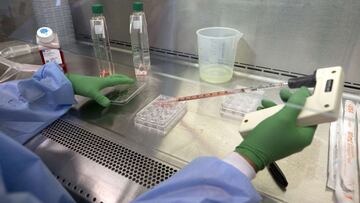Why has male fertilerty halved? Study suggests average sperm counts have declined sharply
A new study published today found that the average sperm count has dropped by 50% since 1973, sparking concerns about fertilerty.


A new study published in Human Reproduction Update suggests that males are becoming much less fertile and that the human race may struggle to reproduce in future if the trend continues.
Researchers found that sperm concentration – the number of individual sperm - has fallen from 101 million per millilitre in 1973 to 49 million per milliliter in the latest analysis. The data comes from a study of 53 countries and appears to suggest that the rate of decline is accelerating.
At this stage researchers have not been able to identify a reason for the sharp decline but some have point to concerns over lifestyle habits and exposure to certain chemicals.
Why is the sperm count study significant?
The new study builds on work gathered in a previous paper published five years ago, which also identified a notable fall in sperm counts. The initial study, published in 2017, was based only on testing performed in North America, Europe, Australia, and New Zealand.
However the more recent investigation was far broader and introduced the idea that declining sperm counts were a global phenomenon. In our sister publication in Spain, El Pais, Professor Hagai Levine, a professor at the Hebrew University of Jerusalem and lead author of the original paper, explained why the findings are so significant.
“We can now say, based on currently available data: sperm quantity has fallen by half in the last 50 years, globally, not just that of Westerners.”
Sperm count among men worldwide is falling at an accelerated rate after halving over the last 40 years, a large new study said Tuesday, calling for action to stop the decline.https://t.co/Ipa5xCtuug
— AFP News Agency (@AFP) November 15, 2022
The recently published study found that numbers had halved from 101 million in 1973 to 49 million in the latest figures, bringing the average close to a worrying threshold. Writing in the 2017 paper Professor Levine said: “Men can be considered subfertile with sperm concentrations below 40 mill/ml and infertile below 15 mill/ml.”
He added: “I think this is another signal that something is wrong with the globe and that we need to do something about it. So yes, I think it’s a crisis, that we [had] better tackle now, before it may reach a tipping point which may not be reversible.”
Will the trend continue?
The consequences of significantly lowered sperm counts on a global scale are difficult for scientists to predict at this stage, but it does appear that the trend is here to stay. In fact, there is evidence to suggest that the rate of decline is accelerating.
When the 50-year period is studied more closely there does appear to be a pattern. In 1985, the rate of decline was 1.31% and by 1995 the annual decline was at 1.90%. If this trend continues, in just a decade the number of sperm could fall below the minimum threshold above which it is more difficult to have children.
Related stories
“We don’t know if it’s going to go further,” said Jaime Mendiola, co-author of the study.
However Mendiola does suggest some potential causes that are likely to remain a part of modern life: “Exposure to chemicals and environmental pollutants has been pointed out as causing a hormonal disruption of the hypothalamus-pituitary-gonads axis that would interfere with sperm production”.

